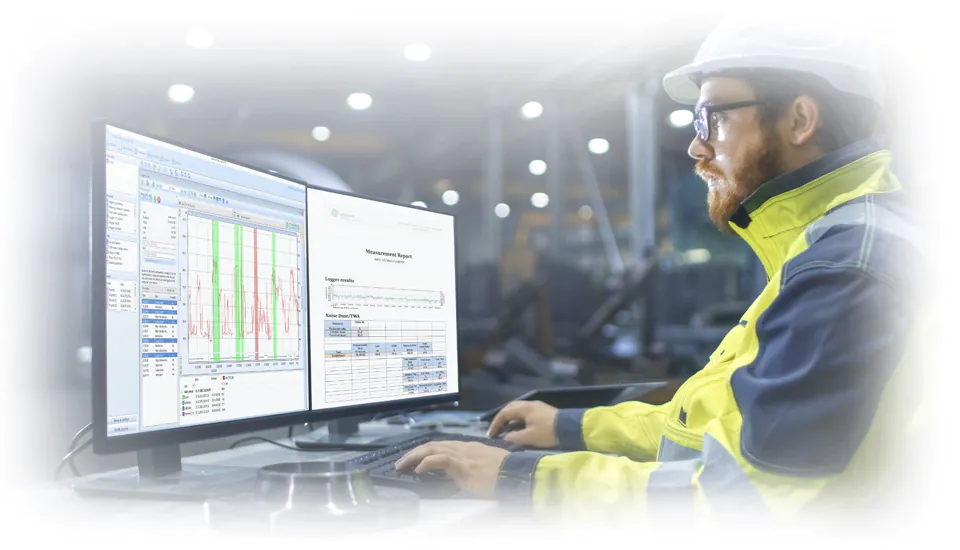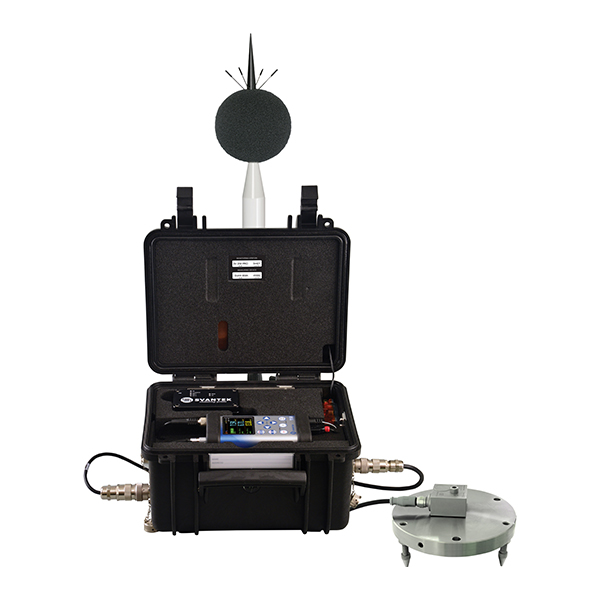
Noise and Vibration Monitoring Stations are essential tools for professionals in the field of occupational health and environmental monitoring. These stations are designed to continuously monitor noise levels over extended periods of time and provide a comprehensive view of the acoustic and vibration environment. Equipped with advanced features such as integrated data loggers, telemetry systems, solar power options, microphone verification, and audio streaming, these monitoring stations are able to collect and transmit real-time data for analysis and decision-making. Whether you’re looking to monitor noise and vibration levels in a construction site, industrial facility, or urban environment, our selection of noise and vibration monitoring stations offers a range of solutions to meet your specific needs and requirements.



Noise and vibration monitoring stations serve a crucial role in occupational health and environmental protection by continuously monitoring and measuring noise and vibration levels in a given environment. These stations are designed to provide long-term, real-time data and insights into the levels and impacts of noise and vibration on individuals and the environment. This information is crucial for assessing the potential health and safety risks associated with exposure to noise and vibration, as well as for evaluating the effectiveness of mitigation measures and making informed decisions to improve conditions. The monitoring stations typically include a sound level meter, a datalogger, and telemetry for remote configuration and data visualization, as well as various other features such as audio streaming and weather monitoring capabilities, to provide comprehensive and accurate data on noise and vibration levels.
A noise and vibration monitoring station typically includes the following equipment:
These components work together to provide continuous and accurate monitoring of noise and vibration levels in the environment, essential for occupational health and environmental protection.
A noise and vibration monitoring station is typically needed in situations where it is important to monitor and assess the levels of noise and vibration in a particular environment over an extended period of time. This may be in a workplace where employees are exposed to high levels of noise, or in an area near construction or industrial activities where vibration levels may be an issue. Noise and vibration monitoring stations are also commonly used in environmental protection efforts to monitor the impact of human activities on local ecosystems and wildlife. These monitoring stations provide valuable data that can be used to assess and manage the potential risks associated with exposure to noise and vibration, and to help ensure compliance with relevant regulations and standards.
The first step in properly installing a noise and vibration monitoring station is to determine the location where it will be placed. The location should be selected based on the area that needs to be monitored and should be free from physical obstructions, wind, and other environmental factors that could interfere with the accuracy of the readings.
Once the location has been selected, the monitoring station should be properly secured to the ground or a solid structure to prevent movement or vibration during operation. The microphone should be positioned at the appropriate height and orientation to accurately capture the sound or vibration being monitored.
It is important to ensure that the monitoring station is properly configured and calibrated prior to use. The settings and parameters should be configured based on the specific requirements of the monitoring application and should be regularly checked and adjusted as needed to ensure accuracy.
In terms of maintenance, regular cleaning and maintenance of the microphone should be performed to ensure optimal performance. The monitoring station should also be checked periodically to ensure that the batteries are charged and that the telemetry and data logging systems are functioning properly.
In the United States, noise and vibration monitoring stations are often used to comply with regulations such as the Occupational Safety and Health Administration (OSHA) regulations for workplace noise exposure, and the Environmental Protection Agency (EPA) regulations for environmental noise.
Proper installation and maintenance of a noise and vibration monitoring station is critical for ensuring accurate and reliable readings that can help protect both the workers and the environment.
Remote monitoring systems for noise and vibration can offer numerous benefits in terms of workplace safety, regulatory compliance, and cost and time efficiency. It is important to ensure proper installation and maintenance of these systems to maximize their effectiveness.
These systems allow for real-time monitoring of noise and vibration levels, providing up-to-date information on potential exposure levels and allowing for prompt action to be taken if necessary. Additionally, remote monitoring systems can greatly reduce the cost and time involved in manual monitoring and data collection, as well as minimize the risk of human error. Remote monitoring systems for noise and vibration can assist employers in complying with regulations by providing continuous, accurate, and automated monitoring of noise levels.
There are several classifications of noise and vibration monitoring stations, including:
It’s important to note that the specific classification of a noise and vibration monitoring station will depend on the specific needs and requirements of the user.
Vibration monitoring is the process of measuring and recording vibration levels as well as comparing results to specified limits to take action when a vibration limit is exceeded. The goal of vibration monitoring is to keep the vibration levels from exceeding the limits and damaging the object being monitored. In many cases, construction vibration (e.g. from a pile driving) can cause costly repairs or downtime. By constantly monitoring construction vibration levels, engineers can address problems before they cause serious damage.
The vibration data from vibration monitoring is used for analysis to determine the cause of the problem. By understanding the root cause of the issue, future incidents with construction equipment can be prevented. There are several ways to do this, including using geophones or accelerometers. By monitoring vibrations, companies can take steps to reduce them when necessary, helping to protect both their workers and the surrounding area.
When selecting a noise and vibration monitoring station, there are several key factors that should be considered in order to ensure that the system meets your specific needs and requirements. These factors include:
By considering these key factors, you can ensure that you select a noise and vibration monitoring station that is appropriate for your specific needs and requirements.
The SV 200A Noise Monitoring Station is a comprehensive solution for noise monitoring applications. This station is designed with a focus on flexibility and durability, making it suitable for both short and long-term measurements. The SV 200 features a fully integrated system that includes an internal web server, real-time data streaming, and battery-powered operation. With multi-profile data logging, real-time 1/1 and 1/3-octave logging, audio event recording, and statistical analysis, this station provides detailed information for advanced post-processing analysis. The SV 200 also has the option for real-time audio streaming and weather condition monitoring. The rugged housing protects the station against harsh environmental conditions, including extreme temperatures and humidity, and is Class 1 compliant with IEC 61672. The system is easy to install, lightweight, and can be powered by a 2.45 Ah internal Li-Ion battery or solar panels. The station also includes a low-power 3G modem or Wi-Fi access point for easy data transmission and real-time data publication.
The SV 258 PRO is a highly advanced building vibration monitoring system designed for measuring peak particle velocity and dominant frequency. It is a perfect solution for construction site monitoring, tunneling and blasting, and measuring human vibration in buildings. The system meets industry standards such as DIN 4150-3 and BS 7385-2 and allows for user-defined curves in FFT and 1/3 Octave bands.
The SV 258 PRO features a tri-axial measurement of vibration plus class 1 noise and is based on the SVAN 958A Class 1 sound level meter. It is portable, battery-powered, and comes in a waterproof case with an IP 65 rating. The system can be powered by an internal battery or an external DC power supply and is ready for direct connection to a solar panel.
The system also features an advanced GSM modem that transmits data to the SvanNET server, allowing for online access and the generation of measurement reports. The system generates SMS and email notifications, as well as visual and audible alarms. The system’s memory saves the time and value of the alarm, and the system’s intelligent charging unit enables the use of a solar panel without the need for expensive controllers or heavy batteries. The case is fitted with rugged, waterproof connectors and all accessories fit conveniently into a second carrying case.
The V 277 PRO is a portable outdoor noise monitoring system based on the SVAN 977 Class 1 sound level meter. It is housed in a waterproof case with an extendable battery and equipped with a lightweight microphone kit. The system provides broad-band results, and real-time frequency analysis, and has the option for time-domain signal recording. Data is transferred via a 3G modem and can be powered by a battery or solar panel. The results can be processed in the SvanPC++ software and the system has various adjustable settings.
SV 279 PRO is an outdoor monitoring system with a Class 1 sound level meter housed in a waterproof case. The system features broad-band results and time-history logging with two adjustable steps and can be used with 3 different filters and 3 detector time constants. The system uses a 3G modem for remote communication and data transfer and can be powered by an internal battery, an external DC source, or a solar panel. The system comes with a lightweight outdoor microphone, waterproof charger, and military standard connectors. The data can be recorded in an expandable 8 GB MicroSD memory and can be analyzed using Svan PC++ software.
SV307A noise monitoring station is an all-in-one environmental noise monitoring station based on a patented MEMS microphone technology covered by a lifetime warranty. The SV307A Noise monitoring station has been designed for permanent environmental noise monitoring in all weather conditions – it uses smart solutions to control the internal temperature and detect any hardware failures. The new housing is made of strong material that protects internal electronics: class 1 sound level meter with 4G and GPS modems. The measurement data includes noise levels, statistics, and spectra together with audio files that can be triggered on level or time. The advanced triggering provides also the possibility of noise prediction to alarm the user before certain noise levels are reached. For the remote monitoring applications, the SV 307A connects to the SvanNET Service, where all measurement data is accessible via a web interface. Moreover, SvanNET makes it possible to connect to SV 307A to listen to the live noise from the microphone.
The SV 803, a new wireless vibration monitor from Svantek, represents the cutting edge of high-technology monitoring devices. Specifically designed for wireless vibration monitoring of both building and ground vibrations in a variety of environmental conditions, this device utilizes geophones as its primary vibration sensors. Geophones are well-known for their high sensitivity and, more importantly, their minimal impact on battery life. This means that the SV 803 can measure vibrations for prolonged periods without the need for frequent battery charging. The vibration monitoring terminal features a battery life of up to 6 months and, when connected to a solar panel, it can sustain ongoing operation.
The new SV 803 vibration monitor has been engineered to meet the rigorous performance specifications of Class 1 as outlined in ISO 4866, BS 7385-1, and DIN 45669-1. These superior specifications enable the device to conduct building and ground vibration monitoring in accordance with measurement techniques outlined in DIN 4150-3 and BS 7385-2. The Class 1 classification of the device makes it an ideal choice for both engineering analysis and field monitoring, as it is capable of providing reliable and accurate measurements
Tel +1 561-912-9809 / 561-9112-7201
E-mail [email protected]
6590 W Rogers Circle Suite# 11&12
Boca Raton – FL 33487
+1 561-912-9809 / +1 561-912-7201
[email protected]
6590 W Rogers Circle, Suite #11&12
Boca Raton, FL 33487